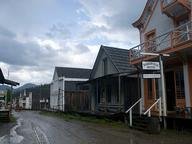19. The California Gold Rush that began in 1848 and lasted until roughly 1855 started at a place called Sutter's Mill. What were the dual occupations of the man who discovered it, a man named James W. Marshall?
From Quiz North American Gold Rushes
Answer:
carpenter and sawmill operator
James W. Marshall, a native of New Jersey, had been employed by Johann (John) Sutter to construct a sawmill for him. In exchange for constructing this mill, Marshall was to receive a portion of the lumber produced. Late one night, in an effort to divert water away from the waterwheel of the mill, this was accomplished, and on the following morning, January 24, 1848, Marshall discovered gold deposits in the channel bed below the mill.
The end result of this discovery was that word of the discovery got out, and people arrived in the thousands to search for more. Marshall grew penniless, and eventually had to file for bankruptcy, since all the workers on the mill had left to find their own gold, and neither he nor John Sutter ever derived any benefit from California's Gold Rush.







 Quick Question
Quick Question Top 20% Rated Quiz,
Top 20% Rated Quiz,